Tuesday, October 7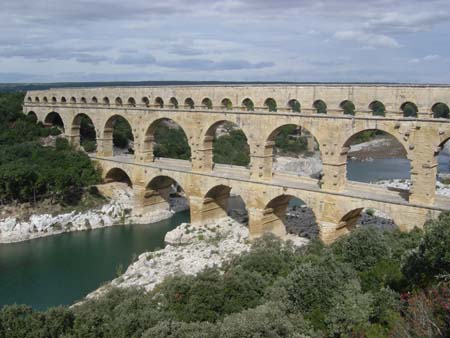
Steve: After completing our standard morning schoolwork
and taking care of some planning, we drove to Pont du Gard, an unbelievably
impressive Roman aqueduct built in 50 AD. We had not planned to spend much
time here, but quickly found ourselves immersed in the history, engineering
and the visual spectacle of the Pont du Gard. 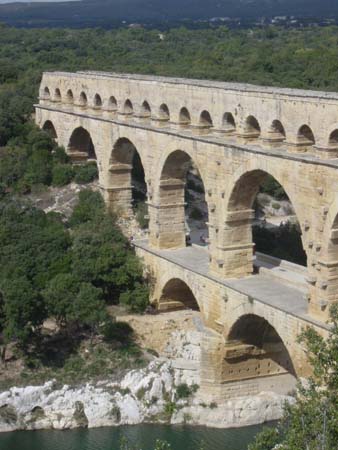
The Pont du Gard was part of an aqueduct built by the Romans to supply water
to the city of Nimes, which had grown rapidly and quickly outgrown its local
water supply. After considering several alternatives, the Romans decided to
bring water in from springs near the town of Uzes, located 31 miles away.
The Uzes-Nimes aqueduct was operational for over 500 years, and at its peak
delivered 44 million gallons of water per day to Nimes to supply its baths,
public buildings and houses. 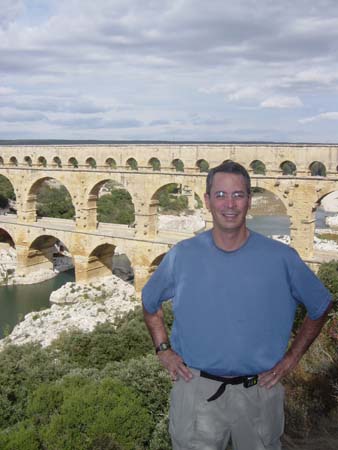
The most amazing feature of the Nimes aqueduct is its incredible engineering
precision. Over the 31 miles, its average slope is approximately 15 inches
per mile, and we learned that the grade was intentionally varied across different
sections of the aqueduct. In fact, on approximately half of its 31-mile span,
the grade is only 7 inches/mile! In total, the aqueduct is only 39 feet higher
at its inception in Uzes than at its final destination in Nimes. It's absolutely
amazing what the Roman engineers w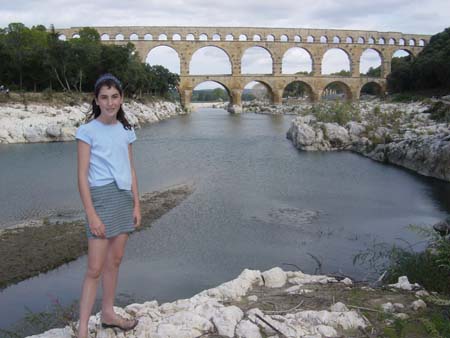 ere
able to do 2,000 years ago…
ere
able to do 2,000 years ago…
Interestingly, over 90% of the Nimes aqueduct is underground. The Pont du
Gard is the highest portion of the aqueduct (and the tallest bridge that the
Romans ever built) and represented the single biggest challenge for transporting
the water to Nimes. However, the overall aqueduct contains a whole series
of tunnels, channels and smaller bridges. It is likely that major sections
of the aqueduct were constructed simultaneously, and that the entire building
process lasted for approximately 15 years. There are no surviving written
records of its construction, so historians have had to piece together information
based on excavations and study of the ruins.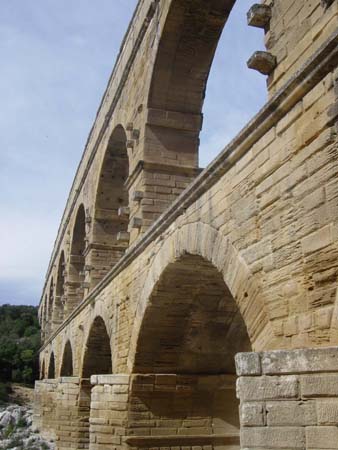
We approached the Pont du Gard from the right side of the river, and we initially walked across the bridge and then up a trail to get a great view looking across the entire span. We knew that the site would be impressive, but it's hard to imagine the sheer size and mass of the structure. Some of the limestone blocks weigh 5-6 tons, and the bridge towers 160 feet over the river. We tried to take pictures of us standing next to the bridge supports to try to capture just how massive it is, but it's hard to do with a photograph. We spent time admiring the Pont du Gard from above, and then walked down to the river and upstream to get a view from below. We enjoyed simply relaxing on the limestone rocks by the river, taking in the scene, and imagining what it took to build such an amazing structure.
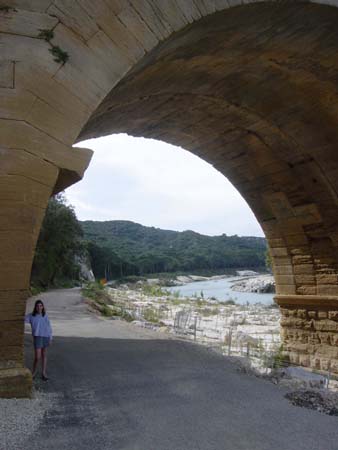 The
Pont du Gard is amazingly well preserved, and stands as a great testament
to the quality of the Roman engineering. It has survived several major floods
through the centuries, and has required only a small amount of restoration.
In 1985 it became a UNESCO World Heritage Site. Our timing today was perfect
- although this spot is touristed by 5,000 people per day during the summer,
today it was virtually empty. This made it possible to really enjoy and reflect
on what we were seeing.
The
Pont du Gard is amazingly well preserved, and stands as a great testament
to the quality of the Roman engineering. It has survived several major floods
through the centuries, and has required only a small amount of restoration.
In 1985 it became a UNESCO World Heritage Site. Our timing today was perfect
- although this spot is touristed by 5,000 people per day during the summer,
today it was virtually empty. This made it possible to really enjoy and reflect
on what we were seeing.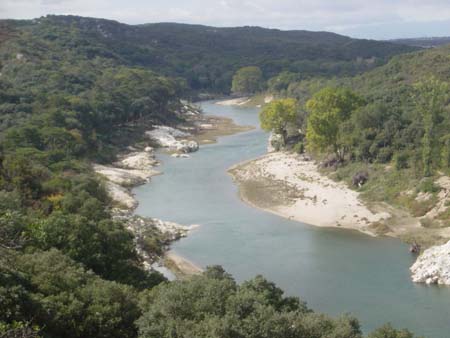
There's a museum on site that covers all aspects of the Pont du Gard, including its construction, the route that was selected by Roman engineers and how the water was used in Nimes. There was also an aerial movie that took us along the entire distance of the aqueduct. The museum is extremely well-done, and we greatly enjoyed spending time learning more about this amazing engineering feat.
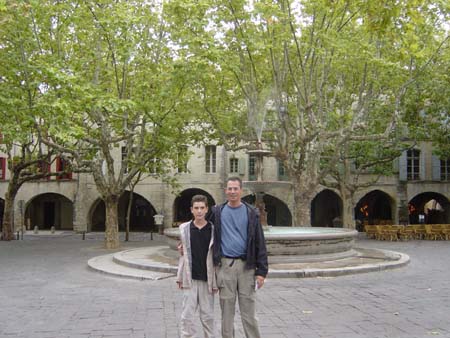 We
had originally planned to also go to Uzes and to Nimes today, but we had spent
too long at Pont du Gard and so we only had time to visit Uzes. Uzes is a
small town located about 20 minutes from Nimes, and is full of picturesque
streets, squares, cathedrals and a palace (this is also where the film Cyrano
de Bergerac was filmed in 1990). We greatly enjoyed following the historical
walking tour as recommended by the local tourist office.
We
had originally planned to also go to Uzes and to Nimes today, but we had spent
too long at Pont du Gard and so we only had time to visit Uzes. Uzes is a
small town located about 20 minutes from Nimes, and is full of picturesque
streets, squares, cathedrals and a palace (this is also where the film Cyrano
de Bergerac was filmed in 1990). We greatly enjoyed following the historical
walking tour as recommended by the local tourist office. 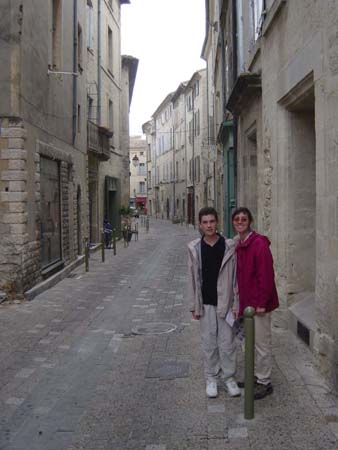 Our
walk took us through several charming areas, and we also had fun stopping
in many of the little shops and bakeries here. There are an amazing number
of cute towns like this throughout Europe, and Uzes clearly is one of the
nicest that we've been to.
Our
walk took us through several charming areas, and we also had fun stopping
in many of the little shops and bakeries here. There are an amazing number
of cute towns like this throughout Europe, and Uzes clearly is one of the
nicest that we've been to.
Tomorrow we'll probably drive either to Aix or to Avignon. We're also waiting for a warm and calm day before heading back into the Camargue for some hiking or biking.
Distance Walked: 3.46 miles
Katie's Komments
The topic for today is… continuation of two of my favorite pieces of artwork in Florence
David by Michelangelo/ Location: The Academia Museum
You enter the room and your vision immediately zooms down to the end of the
hallway where Michelangelo's world famous David stands. He is remarkably enormous.
You walk slowly down the hall to get a closer view of this truly amazing piece
of artwork. When you get there, you study his striking pose with great interest-how
could this have been a symbol for the courageous Florentines? 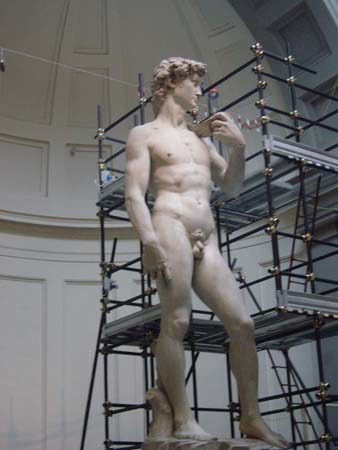
David, sculpted from 1501-1504 by Michelangelo Buonarroti was a very famous and important symbol for the Florentines during early Renaissance times. This 17 foot statue originally stood in The Piazza della Signoria, but was later moved to The Academy Museum where it stands today. Michelangelo broke the mold of David slaying Goliath by not showing him muscular and proud on top of Goliath's head after slaying him, but instead before the killing of Goliath. His striking look and posture shows his determination and strategic thinking before the fight. Why then was this a symbol for the Florentines? The story of David slaying Goliath was that if you had faith in God and believed in yourself you could take over anything-even something ten times your own size. During the early Renaissance times in Florence the Medicis, a powerful aristocratic family, was ruling the city. The Medici family was large, sneaky and extremely power hungry. Their version of David slaying Goliath was that strength and force could kill anything. They believed victory and power was every man's goal in life.
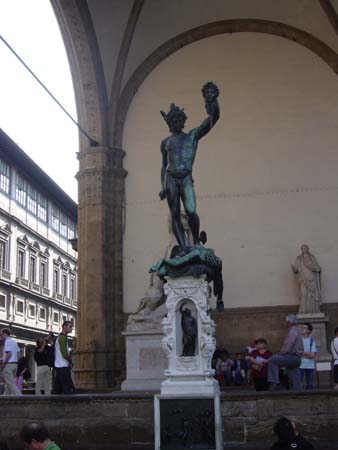 Also
in the Piazza della Signoria is a sculpture commissioned by the Medicis. It
shows Perseus, muscular and strong, holding the head of the monster Medusa.
His pride is clearly visible from his mysterious smile and heroic pose. There
are guts and blood pouring out of Medusa's lifeless head. It is truly disgusting.
This sculpture was in a way saying to the Florentines that if they dared to
revolt against the Medici family their heads would be under Perseus' feet.
Micelangelo's David was sending a message to the Medici's saying that they
believed in themselves and with strategic thinking and faithfulness in God
they could overthrow their family even though they were 10 times the size
of the Florentines. The most remarkable thing about this is that the two symbolic
statues were standing right across from each other in The Palazzo Vecchio,
eyeing each other with determination to become victorious.
Also
in the Piazza della Signoria is a sculpture commissioned by the Medicis. It
shows Perseus, muscular and strong, holding the head of the monster Medusa.
His pride is clearly visible from his mysterious smile and heroic pose. There
are guts and blood pouring out of Medusa's lifeless head. It is truly disgusting.
This sculpture was in a way saying to the Florentines that if they dared to
revolt against the Medici family their heads would be under Perseus' feet.
Micelangelo's David was sending a message to the Medici's saying that they
believed in themselves and with strategic thinking and faithfulness in God
they could overthrow their family even though they were 10 times the size
of the Florentines. The most remarkable thing about this is that the two symbolic
statues were standing right across from each other in The Palazzo Vecchio,
eyeing each other with determination to become victorious.
You then realize that David's determined pose and expression was not only a symbol for the Florentines but also a symbol for the entire Renaissance era. It portrayed the qualities of great importance during these times-personal determination, inner strength, strategic thinking and many other humanistic ideas that were to come and still exist in our ideas about the world today.
.
